Soon after passing the city limits of Seneca Falls it is obvious – you are travelling on historic grounds. “Women’s Rights National Historic Park”, “Wesleyan Chapel”, “National Women’s Hall of Fame”, “House of Elisabeth Cady Stanton”… signs that remind you of what had begun here in the midst of the 19th century on American soil: the fight of women for their rights. They guide you to all of these remarkable spots along the “Women’s Rights Trail”, that celebrate one of the largest social movements in history – the feminist movement. Women’s power, visible and vivid in many places of the city.
Well behaved women seldom make history. – Laurel Thatcher Ulrich
Our first destination we are heading to is – for sure – the women’s museum, situated in the heart of the historical district. Founded in 1969, it aimed to build a home to honor women and their enormous contributions in various fields to the development of the United States. Here it becomes obvious: women wrote history, women write history and they will be a part of history’s future:
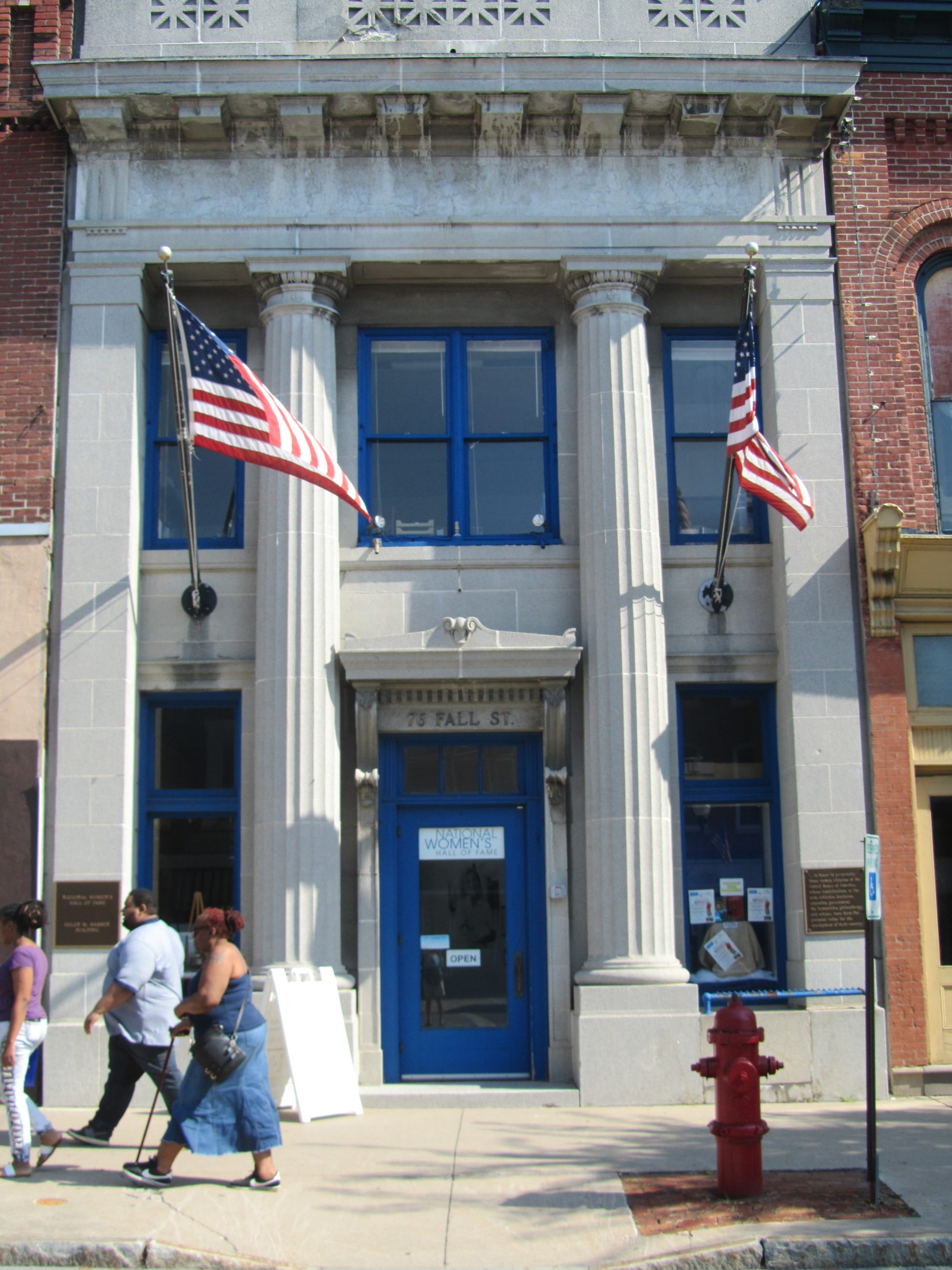
National Women’s Hall of Fame, Seneca Falls, USA
National Women’s Hall of Fame, 76 Fall Street, Seneca Falls, New York State, www.womenofthehall.org
Once in a while we will enter the first women’s museum on our trip. While standing in front of it, I feel joyful and passionate. I remember preparing for this journey:
A few clicks into the virtual space of the American women’s museums – and I again feel this stimulating and animating atmosphere that I name the “american spirit”. It is airy, friendly, inviting, motivating. Within minutes I delve into this inspiring world. It is invisible, but it is there – in between the lines of the websites of the women’s museums. It reminds me of one of my best years in my life, when I had the pleasure to study at an American university. It was exiting to experience that every new idea was welcomed and valued as interesting on principle. Many times I heard as a first reaction: “That sounds interesting. Tell me more about that.” What I was used to from home, was: “Well, okay, but…”
A little bit later I again met with this encouraging attitude, when I contacted the museums to check the opening hours and to announce my visit. It was just great to read their answers: congratulations to my idea to visit all the women’s museums worldwide and to write a book about it; a word of thanks in advance that I will visit them; a heartily welcome in advance.
Out of these experiences I am wrapped up in my “american spirit” now, on the treshold of the museum. Let’s enter. For us, it is a new type of a women’s museum, a Hall of Fame. Not only for us it is something special. The lady at the cashier experiences something new today as well. For her, as one of the honorary workers who make it possible to run the museum, it is the first day in business without help. And then, her first visitors are from overseas. She gives us a summary of the history of the museum, lets us know about interesting details of the exhibition and invites us to ask her questions any time. As we are very curious about the concept of a Hall of Fame, she explains: “You certainly have read our mission outside on our stand:
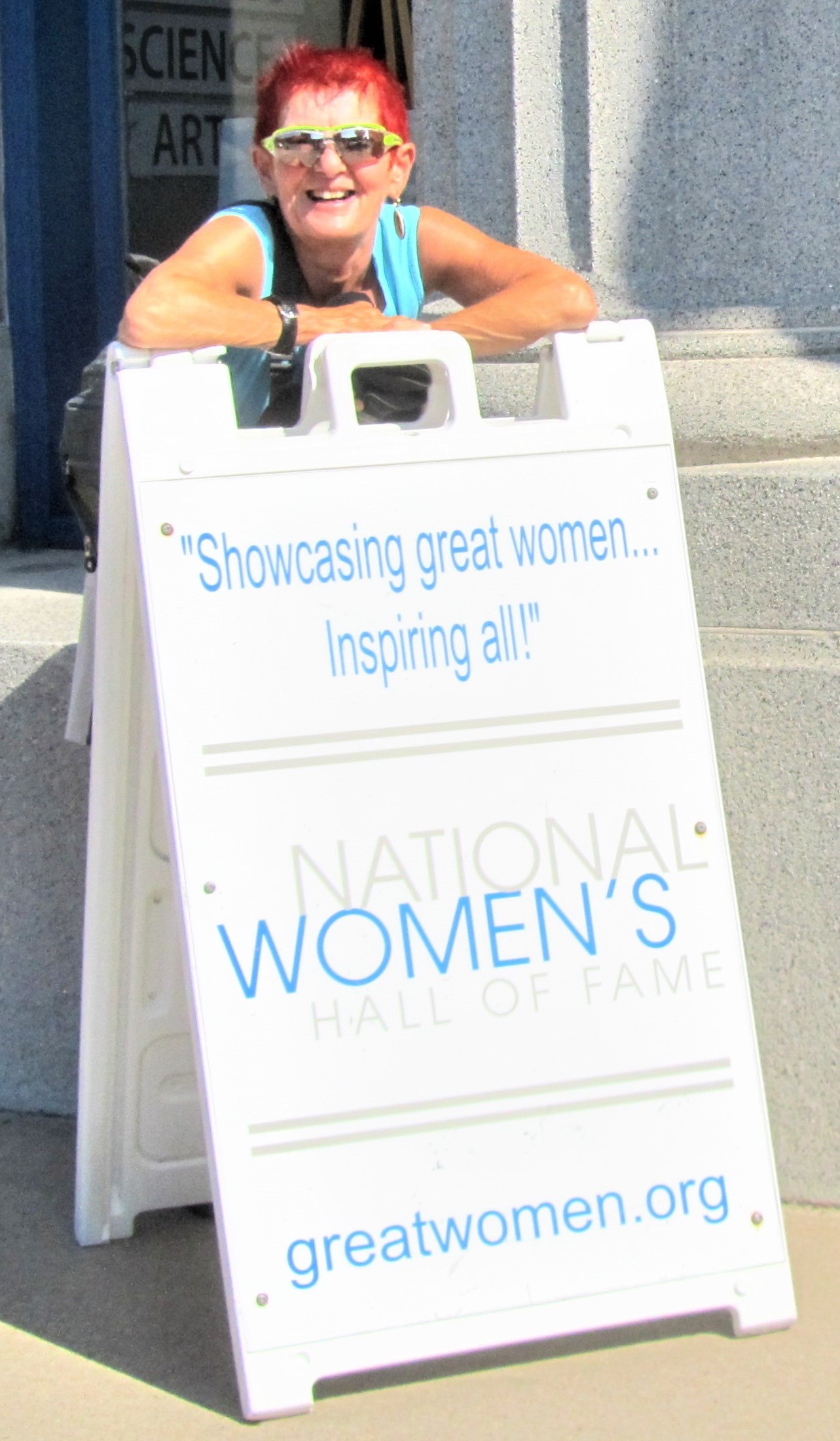
Marianne Wimmer
Showcasing great women…Inspiring all!
Under this motto the museum inducts outstanding women through a rigorous selection process. Everybody may nominate a canditate by submitting a nomination form. Any 2 years there is a nomination ceremony. A panel of judges, comprised of distinguished citizens who are experts in their fields, is scoring the nominees. Any 2 years the panel members shift as well. Nominees may be historical or contemporary, but they must be citizens of the United States. They are chosen on the basis of 4 core questions:
- What did the woman contribute to the American society?
- What national or global outreach did her contribution have?
- What did she have to overcome to make her contribution?
- Did her work open doors for other women to follow in her footsteps?
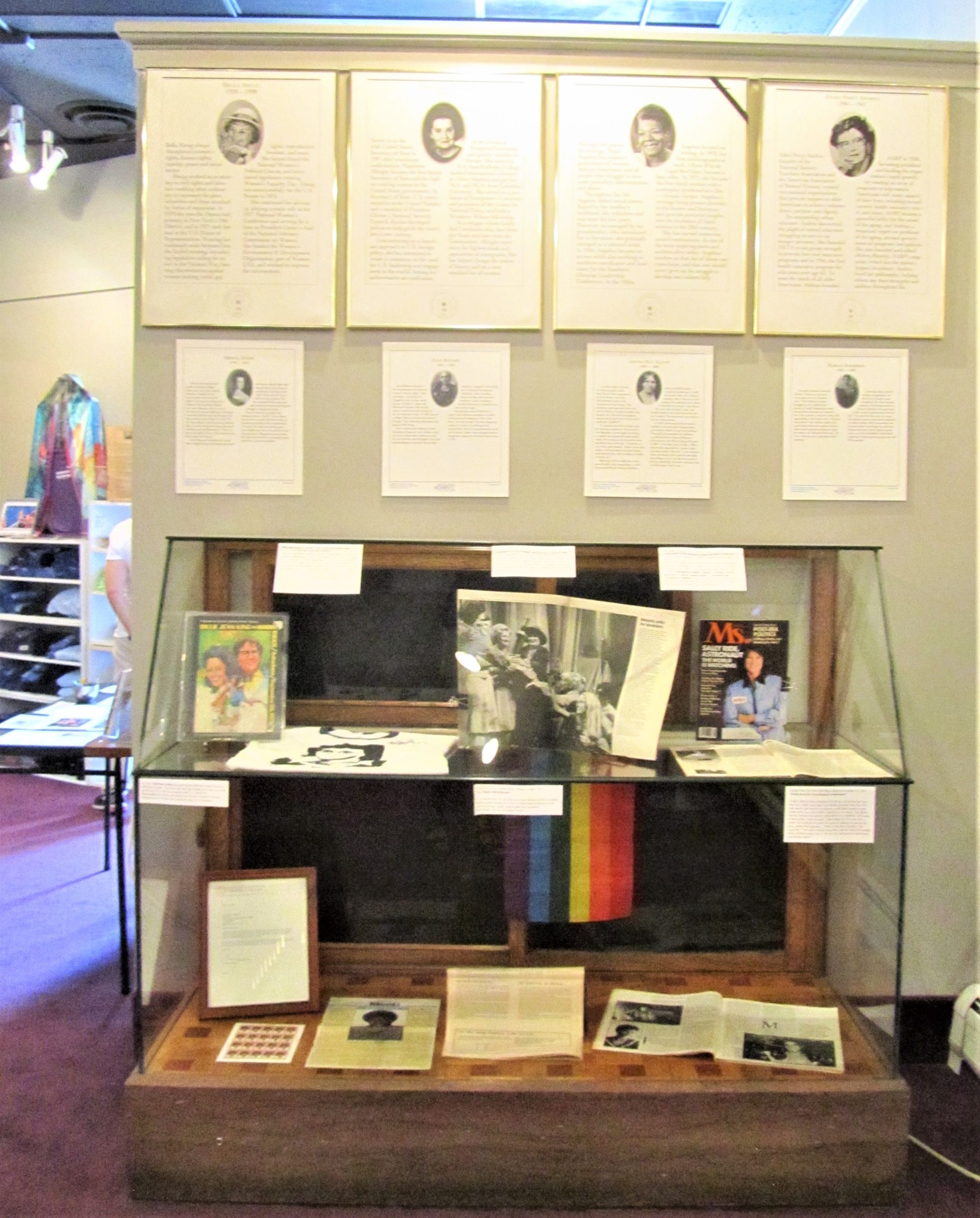
View into the National Women’s Hall of Fame
With this concept the visitor gets to know not only historically certified personalities, but also outstanding contemporary ones. They write history nowadays without intending it. Who knows, who of them will end up as great name in the national historiography. You may immerse yourself in the lives of the inductees while looking at their portraits and reading about their life stories, presented on the walls in the form of framed pictures. Besides you will find objects of importance, that tell additional stories about them. At the time of our visit the gallery honored 276 women out of 78(!) fields, from A like Abolitionist or Adventurer…, to Biologist…, Historian,… Mathematician,… Nobel Laureate,… Scientist… up to Y like Youth Group Founder.
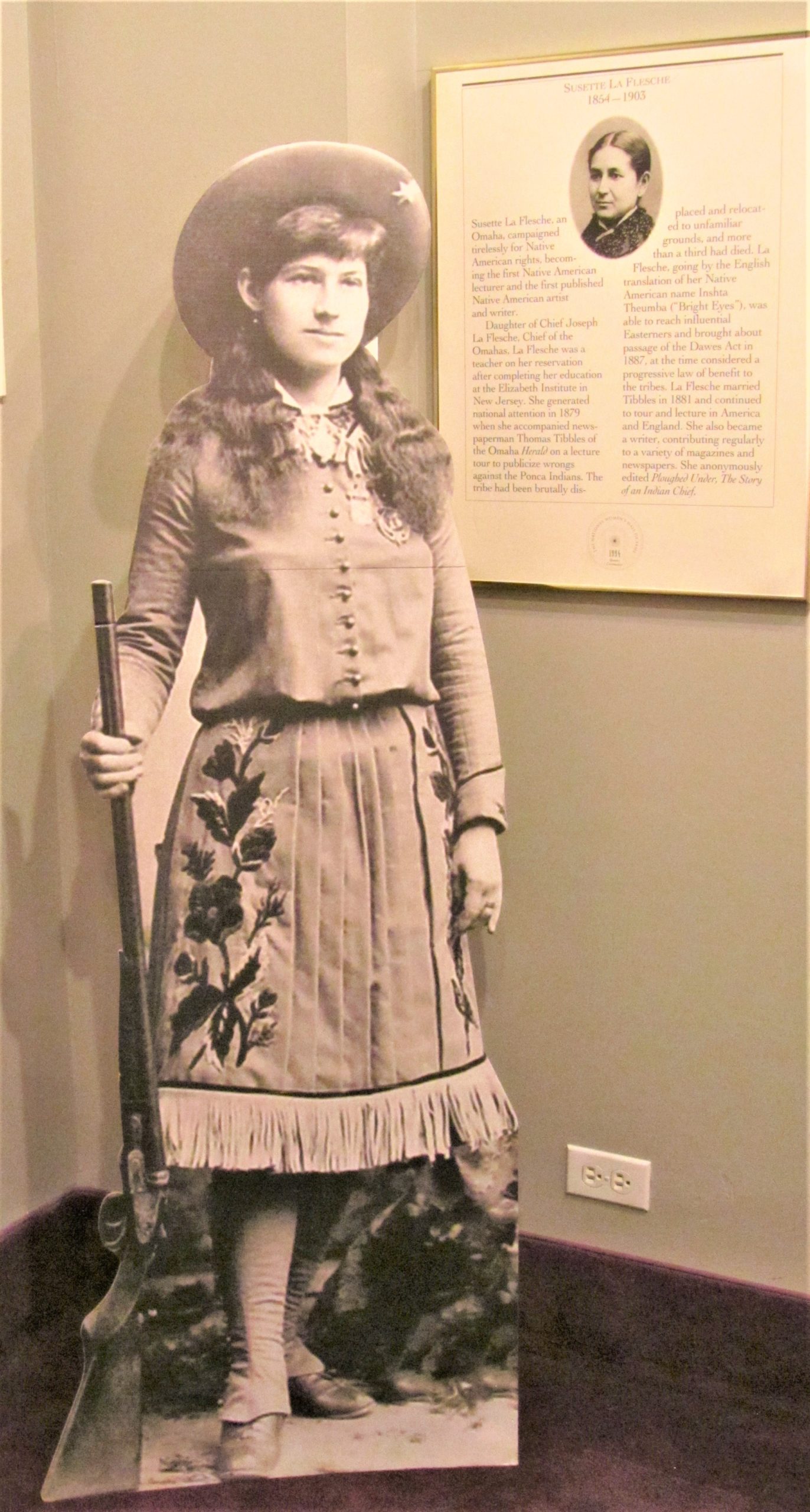
Annie Oakley, Star of Buffal o Bill’s Wild West Show
It is impossible for a visitor to read all the interesting texts within one visit. Luckily you will find a book in the museum’s shop that contains them all. In addition we get help for finding our way by the lady who looks after the museum today:
You notice that some pictures are decorated with a riband. A purple-gold colored riband means that this woman was a suffragette; a black one shows that the woman was inducted during her lifetime but has already died.
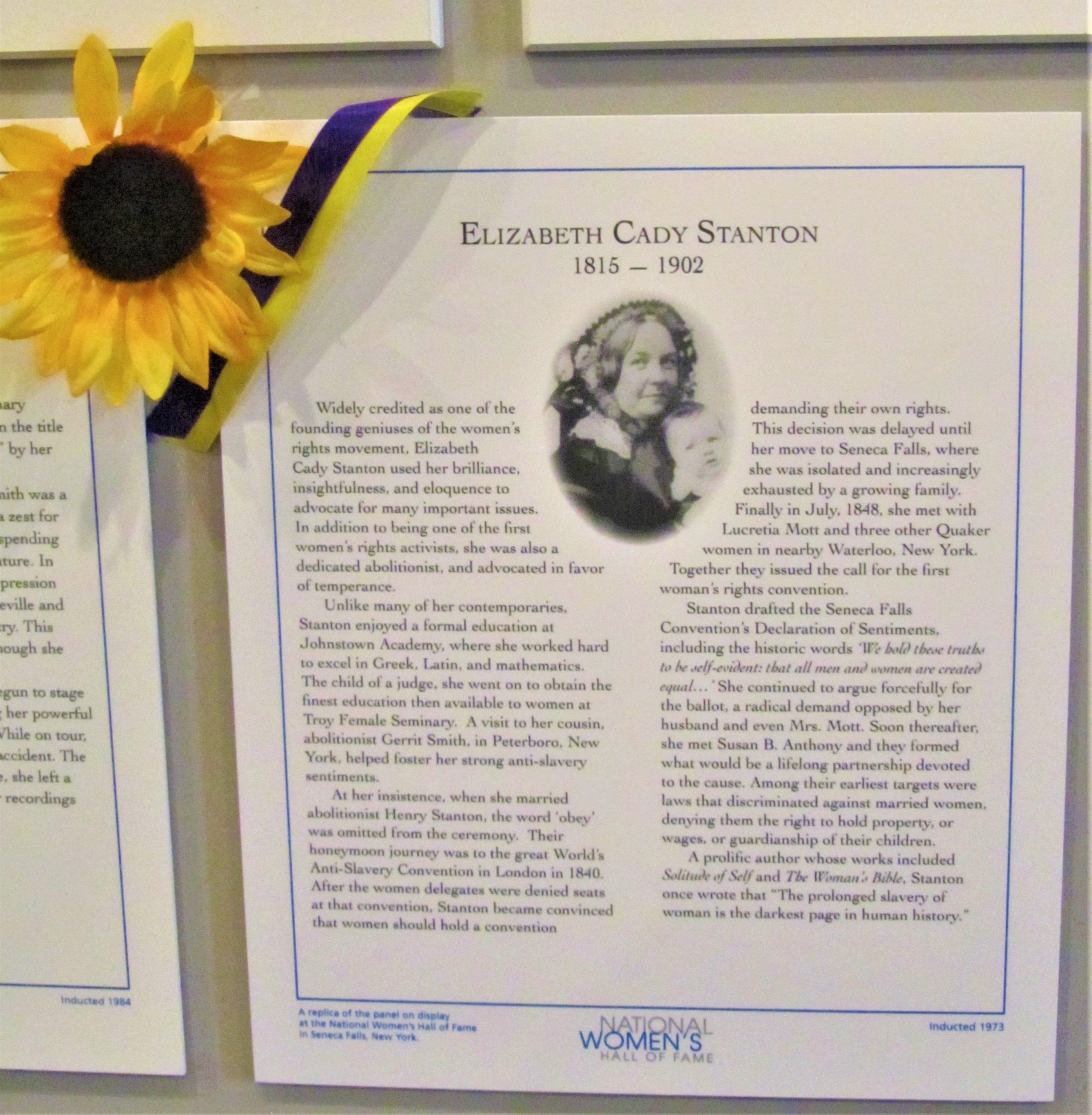
Elizabeth Cady Stanton
While wandering from one suffragette to the next, I am puzzled, as I face Hillary Clinton out of a sudden on my way. I run into a well-done, very lively looking silhouette of her, made of cardboard. Shortly before you say “Hallo”, you realize – It is fake at its best. There are more of these cardboard figures, highlighting some other impressive historic personalities, like Susan B. Anthony, Harriet Tubman or Annie Oakley, the famous woman with the rifle.
After having met that many distinguished women and their enduring contributions it is seducing to answer the questions, you read on a board:
Who inspires you? Why?
A big number of post-its on the board show, that many visitors already took their time to answer. For me it is a welcome break and a chance to turn everything over in my mind, I have seen up to now. Preferring comfortable clothes and solely wearing pants I choose Amelia Bloomer (1818 – 1894) as my favorite. She was the first woman to own, operate and edit a newspaper for women in 1849, called “The Lily”. It provided an intriguing mix of contents, from recipes to articles about women’s inequities and issues of women’s rights. She recognized that the fashion of that time did not allow women freedom of movement. In her newspaper she therefore popularized and defended loose pants and a tunic as an adequate outfit. Although she was not involved in creating this attire, it was named after her and known as “The Bloomer Costume”. Many suffragettes wore it, but ultimately they abondoned the comfortable clothing. As they were ridiculed more and more, too much attention was centered on their outfit instead of the much more important issues of women’s rights.
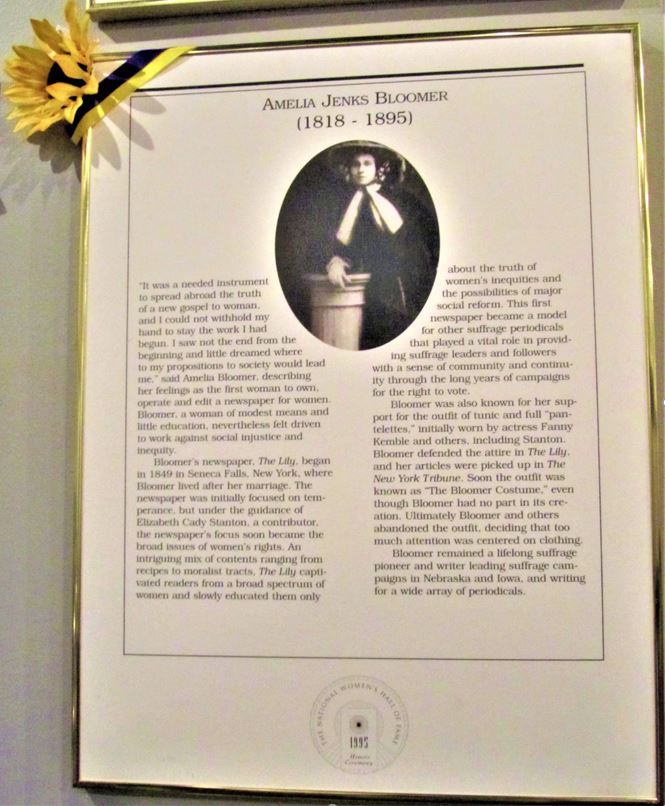
Amelia Bloomer
These clothes make it easier for me to run from the cradle to the desk, from the kitchen to the parlor, at this moment to sing a cradlesong in the children’s room, and at the next one the melodies of good old Tom Moore on the piano-stool. How could I manage all this wearing long skirts. – Elisabeth Cady Stanton, 1851 (translated from German to English by myself)
Answering the questions of the board, makes me think of Austria and the suffragettes of my own country. It inspires me to found the Austrian National Women’s Hall of Fame, at least on paper. A worthwhile task to do, as it comprises to recapitulate my own history.
Besides the main contents of the museum with its portraits of outstanding women, it is as well worthwhile paying attention to topics that are presented less central.
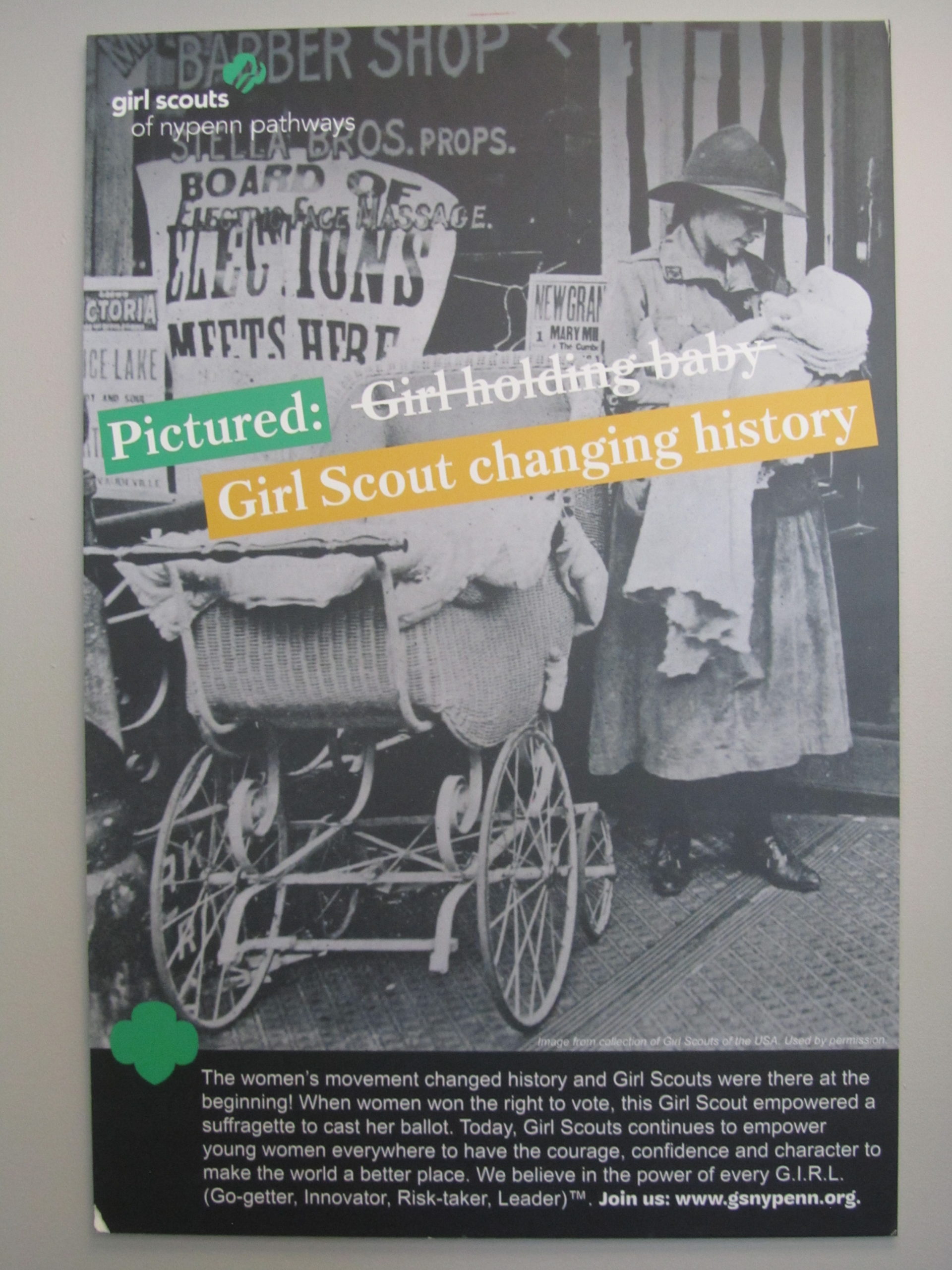
Poster: Girl scout changing history
I discover a poster that deals with one of my favorite themes: language and its use. It sheds light upon the way history is created by words. Does the girl scout on the poster just hold a baby – as the original title suggests, or does she change history by doing that, as she enables a suffragette to engage in voting? Sometimes one or two words are sufficient to create a new understanding of our world. Isn’t that fascinating? I also like, how the word G.I.R.L is interpreted. For every letter the girl scouts find an “activating” word: Go-getter – Innovator – Risk-taker – Leader. Yes, that is what girls are. It breaks with the stereotypes that were/are handed down for centuries, and focuses on a new perspective on girls’ lives and consequentely on women.
Seneca Falls – a town full of women’s history
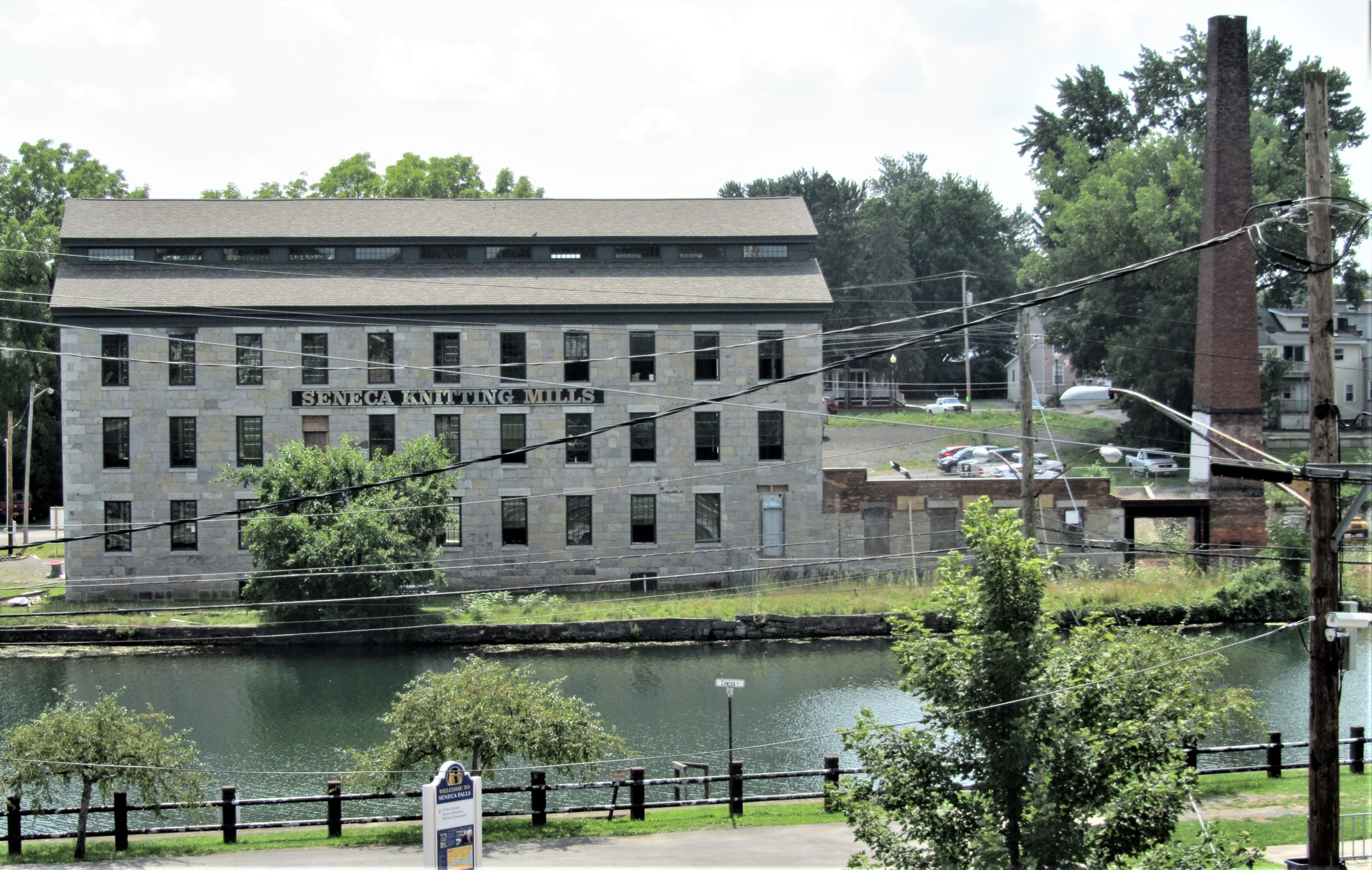
Seneca Knitting Mill / new home of The National Women’s Hall of Fame
Not only the women’s museum is dedicated to ensuring the visibility of American women’s history – Seneca Falls itself is full of it. With our visit of the National Women’s Hall of Fame, we got to know the main protagonists of the women’s rights movement. Now we are eager to visit the feminist hotspots in town, where these famous women acted and fought for their rights. On the point of doing that, we view Seneca Knitting Mill, which will house the women’s museum from 2020 onwards. As this historic building (1844) on the Erie Canal was largely employed by women, it will be a dignified home for the Hall of Fame. At that time the manufacturing plant was owned by some men, who joined the suffragettes and signed the “Declaration of Sentiments”. As abolitionists, they refused to use cotton in the mill, that had its origin in slave work. This was a highly revolutionary attitude at that time. Why did all that happen exactly here, in Seneca Falls?
Let’s take a look at the midst of the 19th century: In the 1830ies and 1840ies many Quakers settled in the area. Their religion had a big influence in various ways. They opposed slavery and boycotted slave-made goods. From their religious point of view, they viewed women and men as equal in the eyes of God and provided model relationship where both sexes lived in equality. Thus, for Quaker women it was just a logical next step, to demand equal rights. Society excluded women from many things, either by law or by costume, declaring it indecent for true ladies. Unmarried women were not allowed to vote, to speak in public, hold office or attend college. For earning a living they were limited to be a teacher, a seamstress, a domestic or mill worker. Married women could not make contracts, sue in court, divorce their husband or gain custody of their children. They could not own property, not even the clothes they wore. Women’s lives were controlled and directed by husbands or fathers. Wherever you look at – restrictions. But strong women put up resistance, the traces of which we want to follow now on the Women’s Rights Trail.
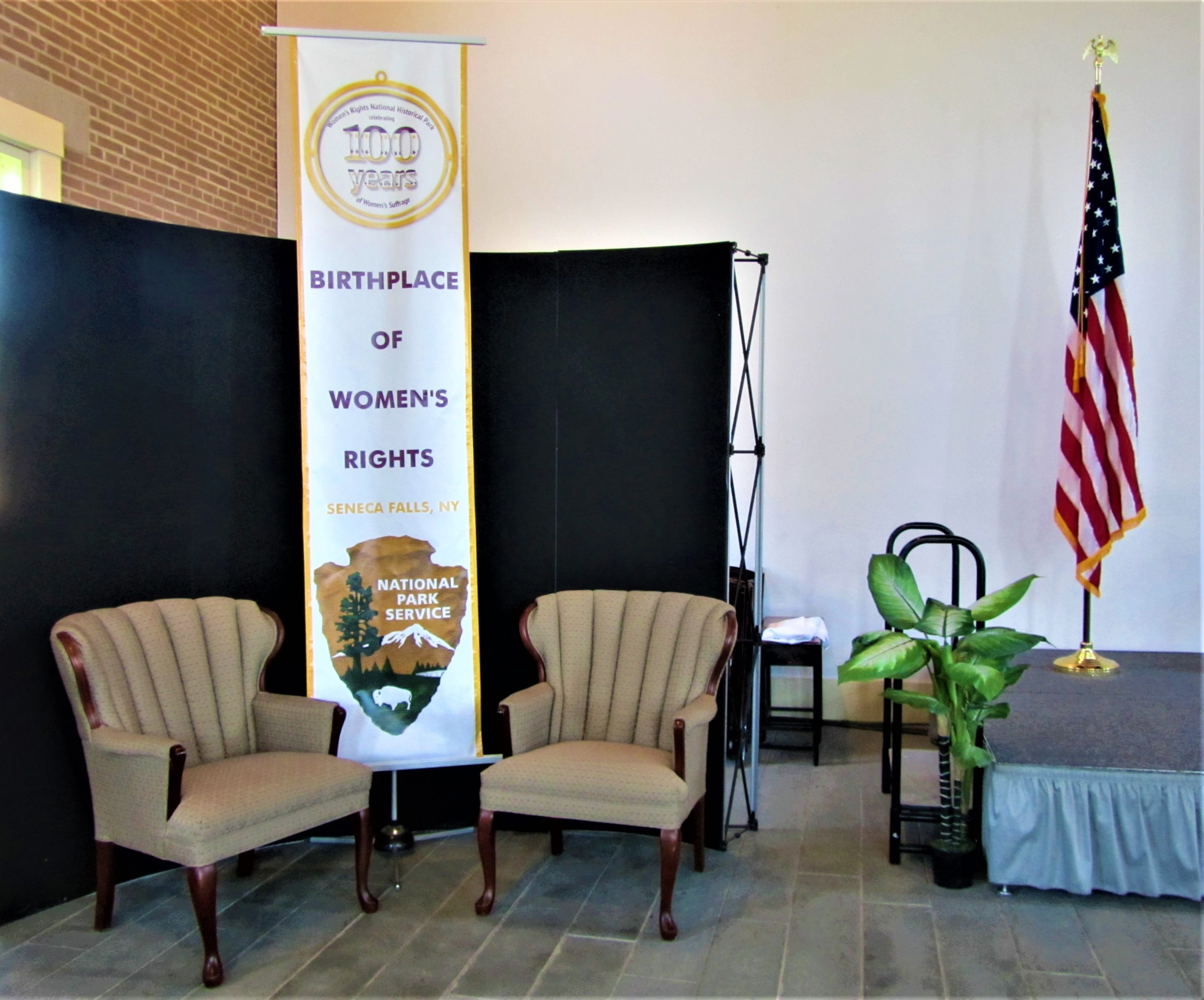
Wesleyan Chapel
First of all, we go to the birthplace of women’s rights, to Wesleyan Chapel. In 1848, Elisabeth Cady Stanton and her followers, some 300 women and men, gathered, discussed, and in the end signed the “Declaration of Sentiments”, that all women and men are born equal. It was the first step towards the right for women to vote. It took a 72-years fight, up to 1920, to put it into operation throughout the United States.
Moving on to the neighboring Women’s Rights National Historic Park, you cannot overlook Elisabeth Cady Stantons famous words from the 1st draft of her important document on the buildings wall:
We hold these truth to be self-evident: that all men and women are created equal.

Women’s Rights National Historic Park / visitor center and museum
For us, it is a must to head to the House of Elisabeth Cady Stanton. The longer we move through the town, the more we get aware of Seneca Falls importance for women’s history.
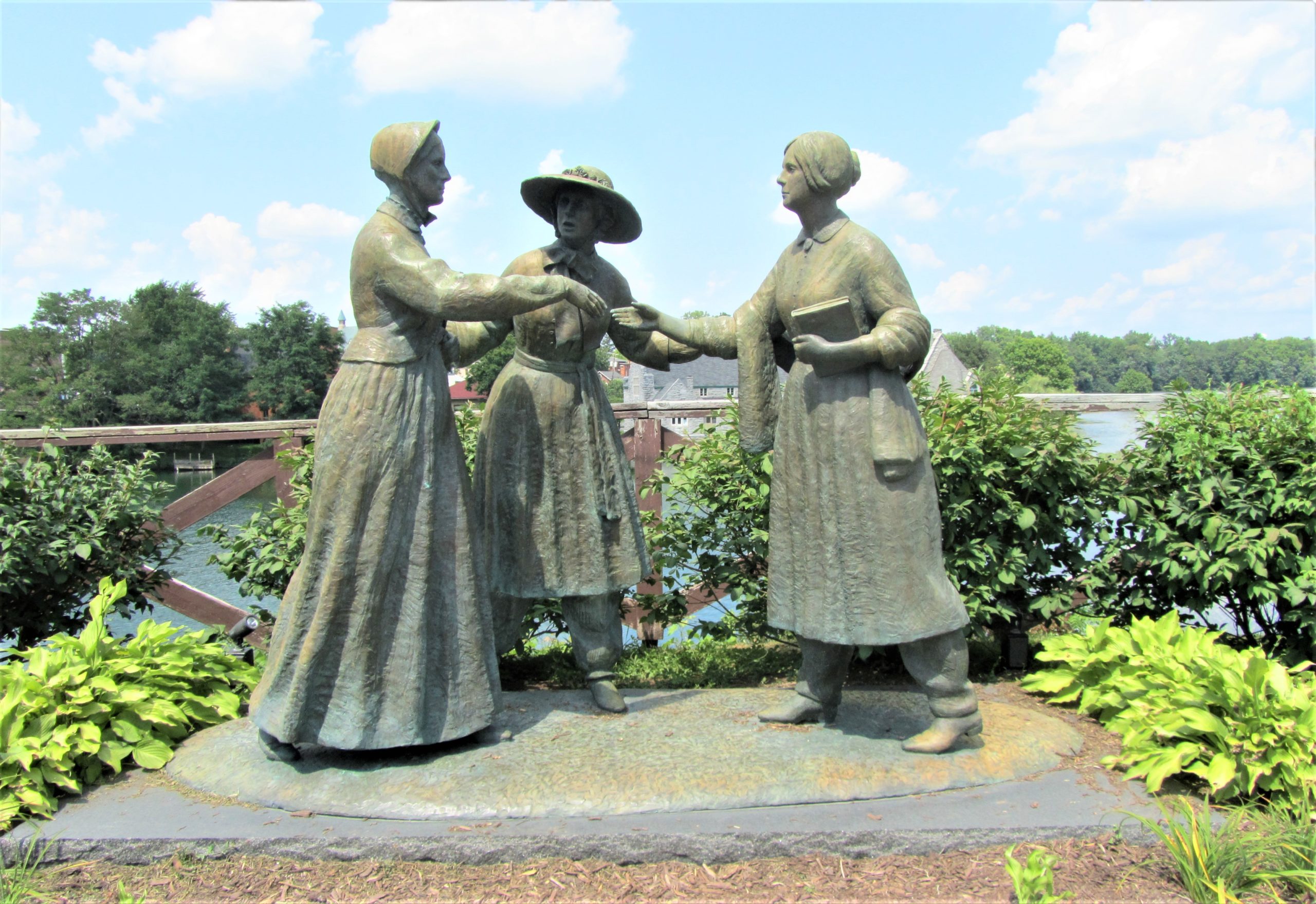
When Anthony met Stanton
On our way we pass by a statue that commemorates the meeting of three women in 1851, that turned out to become a historical occasion of great consequence. It gave direction and momentum to the struggle for women’s suffrage. Amelia Jenks Bloomer introduces Susan B. Anthony to Elisabeth Cady Stanton. Between Anthony, who was childless, and the seven-fold mother Stanton a lifelong friendship and allience was forged. Anthony supported her friend in her domestic duties so that she was able to write her speeches. Anthony, as a single woman not burdened with much housework, travelled the countryside with Stanton’s speeches, campaigning for women’s rights.
The following episode shows what a persevering and consequent personality Stanton was. At her wedding she insisted to omit the word “obey” from the marriage vows. And where do you think, did they spend their honeymoon? The couple went to London to attend the World Anti-Slavery Convention. Afterwards they lived for some time in Boston, were Stanton – as a highly educated woman – immersed herself in the city’s exiting cultural, political and social scenes. After the couple had relocated to Seneca Falls, Stanton felt like a “caged lioness”, compared to Boston. Living in a small-town isolated 19th-century household, she lacked the intellectual and cultural stimulation of her former life. Childcare and household – despite her 7 children, her life felt unfulfilling:

House of Elisabeth Cady Stanton
The isolated household is for a great part responsible for women’s ignorance and humiliation. An intellect that only is in contact with servants and children, whose aspirations and ambition does not go beyond the roof, that protects her, necessarily hampers women’s best development. – Elisabeth Cady Stanton (1815 – 1902), Susan B. Anthony (1820 – 1906), Matilda Joslyn Gage (1826 – 1898), American pioneers of the Women’s Rights Movement, 1881, (translated from German to English by myself).
To honour Elisabeth Cady Stanton and her outstanding achievments that changed the lives of women in America, I’d like to finish with her core questions, that even for us, women living in the 21st century, are worthwhile to think about:
- Which of our present efforts will contribute toward a future of equality?
- What are we next to do?
Written by: Marianne Wimmer, collector of women’s museums
Previous blog post: Women At Work Museum, Attleboro, USA
Upcoming blog post: Susan B. Anthony Museum & House, Rochester, NY